Home
About VSI
What We Do
Who We Are
Contact Info
Resources
Blog
Data Archives Export
Tower Construction
Foundation Planning and Preparation
Tower Siting
The location of the tower is constrained by a number of considerations:- The tower needs to be at least 130' high, with a little extra height (140') highly desirable to accommodate future tree growth. The base of the tower can be no closer to the nearest property line than the height of the tower, 140'.
- The tower should be as close to the house as possible to minimize the length of the coaxial antenna lines; not only because of the cost per foot, but also because of lines losses that attenuate the signal strength.
- The house is close to the southern property line, and the lot slopes down to the north. So, we want the tower to be as far south as possible (subject to the 140' zoning setback requirement). That places the tower on a line parallel to the south property line, running roughly east-west
- We want to steer clear of the multiple buried electrical, communciations, and water lines on the property. That consideration places the tower to the east of the house due to the buried power, phone, and water lines running from the east corner of the house to the garden shed to the north.
- At some point it will be necessary to service the antennas at the top of the tower, preferably without paying thousands of dollars for crane service. Antennas can be raised to and lowered from the tower via what are known as "tram" or "trolley" lines, provided there is sufficient clear area on the ground to one side of the tower. A clear area is also needed initially for assembly of the tower structure on the ground prior to its initial erection. The selected tower location has a clear area to the west that satisfies both purposes.
- Finally, we prefer that the tower not be prominently visible from the house windows we look out of the most. As it happens the other considerations have already constrained the tower location to within a few feet at this point, but as sheer dumb luck would have it the tower is not visible from any main windows without neck-craning.
Geotechnical Report
The geotechnical boring was done on September 18 by Hillis-Carnes. They used a special track driven drilling rig designed to take soil samples at multiple depths. Over a period of several hours three separate boreholes were drilled with samples taken at multiple depths from each borehole.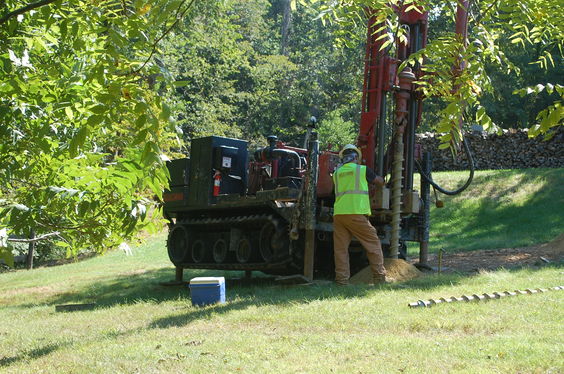
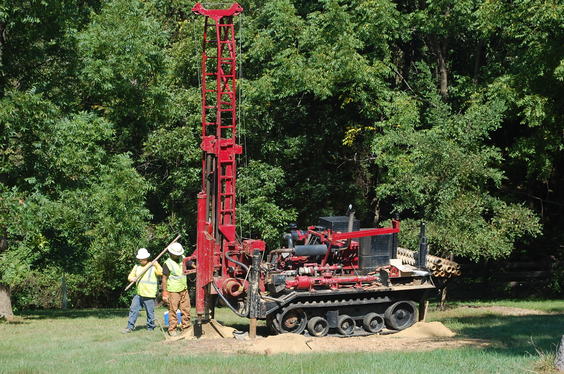
Foundation Design
As of February 2016 we have the final engineering design and the anchor bolts and "template kit"; the latter being a metal framework to hold the three sets of anchor bolts in position as the concrete is poured around them. Unfortunately the specifications for installation of the anchor bolts have not been supplied yet (apparently there is a "ANCHOR BOLT LAYOUT DRAWING" that should have been supplied but wasn't). This has been requested from the tower manufacturer, Rohn, and after a week and a reminder still no reponse. The very slow responsiveness from Rohn has already extended the timeline for this project considerably.Most of the planning for the foundation is done. The excavation will be done by Mike Roderick. A custom concrete mix to satisfy the design requirements has been specified by TBH. Rebar and Sonotubes will come from Frederick Brick Works. The 120v electrical circuit will be installed by Chuck LoSchiavo of Gateway Electric. Only two items remain; the missing specifications on the anchor bolt installation and finding a crane service that has a suitable crane for the uneven terrain and the height and weight (9,000lb) of the tower.
Layout
It's now May 2016, all the planning issues have been addressed and the ground is finally getting dry enough to allow concrete delivery. Jay Bubel of TBH visited the site and concluded that they would be able to drive right up to the excavation, though he said he wouldn't send just any of their drivers. A complete list of materials (rebar, Sonotube, etc.) was prepared with Frederick Brick Works and is ready for delivery. After closely watching the weather Mike Roderick is scheduled to begin the excavation on Sunday May 15. Batten boards and stringlines have been placed to outline the foundation footprint: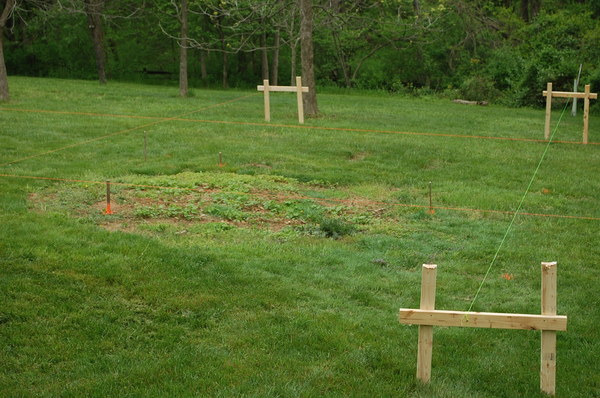
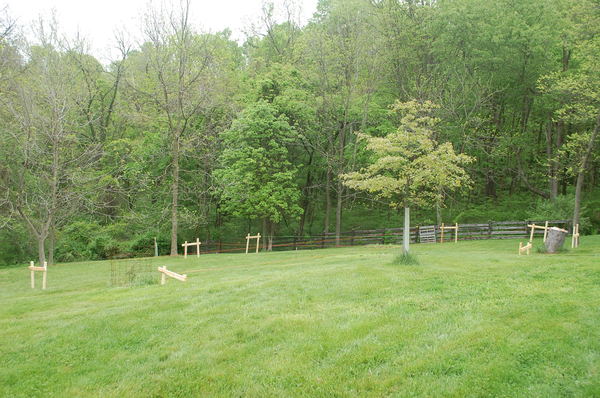
Note the stringlines are not level; to do so would have had some of the batten boards about twelve feet in the air. Instead the stringlines all lie in an inclined plane, with the four corner intersections vertically above the level (horizontal) projection of the footprint. As a result the stringlines define a rectangle in the plane of the stringlines, not the square 18'-6" by 18'-6" of the foundation mat. Doing non-level stringline like this turns out to be considerably more tedious that laying out a level one.
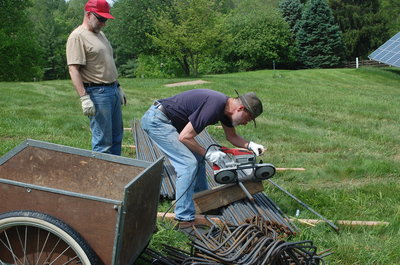 The rebar (most of it) was delivered on Saturday May 14 along with the round pier forms and concrete
block (CMU). Since the pier forms basically consist of cardboard they shouldn't be exposed to rain
any more than necessary, so we put them in a garage bay safely out of the weather until needed.
The rebar (most of it) was delivered on Saturday May 14 along with the round pier forms and concrete
block (CMU). Since the pier forms basically consist of cardboard they shouldn't be exposed to rain
any more than necessary, so we put them in a garage bay safely out of the weather until needed.
We had 96 pieces of #7 rebar (7/8" diameter) 20' long that needed to be trimmed to 18'. Rebar can be hard to cut because it is made of recycled mystery metal that can have very hard areas that trash saw blades. Cutting with an abrasive disk is messy and slow, so I was hoping to make those cuts with a portable bandsaw. In preparation I bought six blades and checked that I could buy more locally. My brother was visiting and helped with the rebar cutting; it turned out we made all 96 cuts with a single blade, though it was showing a little wear at the end.
In total there will be about 4,400 lbs of metal in the foundation, embedded in about 103,000 lbs of high strength concrete. The bottom 18'-6"x18'-6" foundation mat will be covered with 83 cubic yards of dirt weighing about 270,000 lbs. So the 9,000 lbs (4,100kg) of tower structure above ground is anchored by a 377,000 lb (171,000kg) foundation. If this tower ever falls I don't think it will be due to foundation failure.
|
This site Copyright © 2002-2016 VSI. |